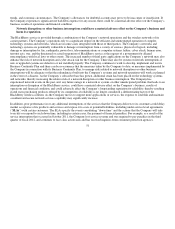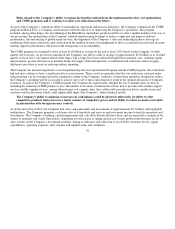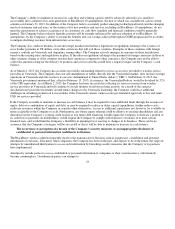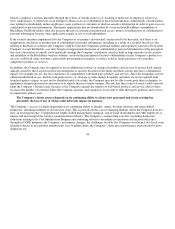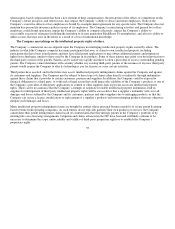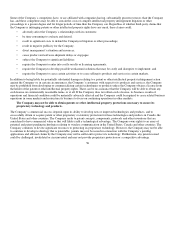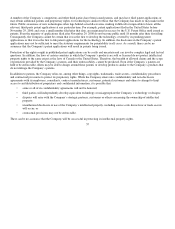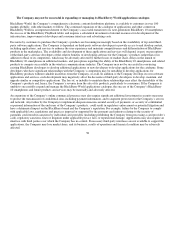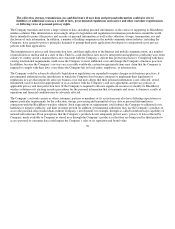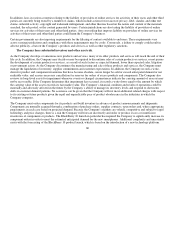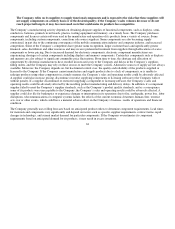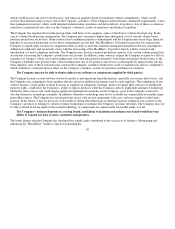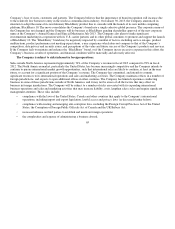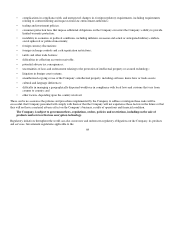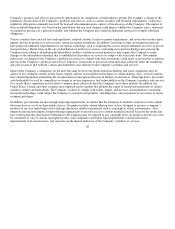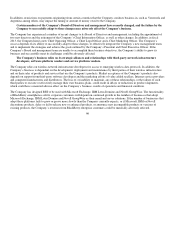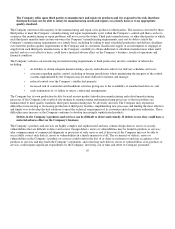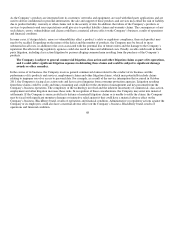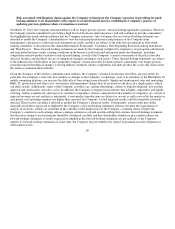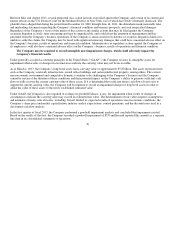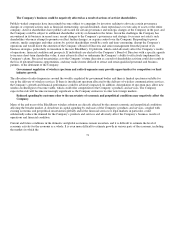Blackberry 2013 Annual Report Download - page 68
Download and view the complete annual report
Please find page 68 of the 2013 Blackberry annual report below. You can navigate through the pages in the report by either clicking on the pages listed below, or by using the keyword search tool below to find specific information within the annual report.
The Company relies on its suppliers to supply functional components and is exposed to the risks that these suppliers will
not supply components on a timely basis or of the desired quality; if the Company’s sales volumes decrease or do not
reach projected targets, it may face increased costs that could make its products less competitive.
The Company’s manufacturing activity depends on obtaining adequate supplies of functional components, such as displays, semi-
conductors, batteries, printed circuit boards, plastics, tooling equipment and memory, on a timely basis. The Company purchases
components and licenses certain software used in the manufacture and operation of its products from a variety of sources. Some
components, including custom components, come from sole source suppliers. Some components are also becoming supply
constrained, in part due to the continuing convergence of the mobile communication industry and computer industry, and increased
competition. Some of the Company’s competitors have greater name recognition, larger customer bases and significantly greater
financial, sales, distribution and other resources and may receive preferential treatment from suppliers through allocations of scarce
components or lower pricing. Due to increased demand for electronic components, electronic component manufacturers are
experiencing shortages of certain components including displays and memory components. Certain key components such as displays
and memory are also subject to significant commodity price fluctuations. From time to time, the shortage and allocation of
components by electronic manufacturers have resulted in increased costs to the Company and delays in the Company’s suppliers
filling orders, and the Company may rely on these sources to meet the Company’s needs. Alternative sources of supply are not always
available. Moreover, the Company depends on, but has limited control over, the quality and reliability of the products supplied or
licensed to the Company. If the Company cannot manufacture and supply products due to a lack of components, or is unable to
redesign products using other components in a timely manner, the Company’s sales and operating results could be adversely affected.
A supplier could also increase pricing, discontinue or restrict supplying components or licensing software to the Company with or
without penalty. If a supplier discontinued or restricted supplying a component or licensing software, the Company’s sales and
operating results could be adversely affected by the resulting product manufacturing and delivery delays. In addition, if a component
supplier failed to meet the Company’s supplier standards, such as the Company’s product quality standards, and as a consequence
some of its products were unacceptable to the Company, the Company’s sales and operating results could be adversely affected. A
supplier could also file for bankruptcy or experience damage or interruption in its operations due to fire, earthquake, power loss, labor
disruptions, telecommunications or computer systems failure, the effects of the current economic downturn, human error, terrorist
acts, war or other events, which could have a material adverse effect on the Company’s business, results of operations and financial
condition.
The Company generally uses rolling forecasts based on anticipated product orders to determine component requirements. Lead times
for materials and components vary significantly and depend on factors such as specific supplier requirements, contract terms, rapid
changes in technology, and current market demand for particular components. If the Company overestimates its component
requirements based on anticipated demand for its products, it may result in excess inventory,
61


